
ANZAC cover art of The Queensland Digger
15 July 2025- History & commemoration
Poignant and powerful, early covers of The Queensland Digger spoke of war and loss in ways that only art can.
Dr Susan E. M. Kellett
Over the past century, the covers of The Queensland Digger (now Queensland RSL News) have illustrated the progress of the RSL and the events that have affected its evolution.
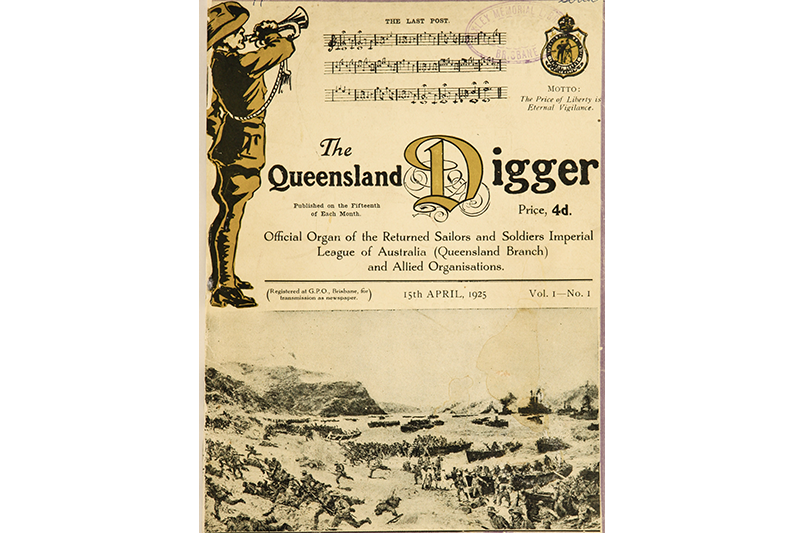
The cover of the first edition of The Queensland Digger in April 1925
In this first instalment of a two-part series on selected publication covers, the stories of two early images related to ANZAC Day reveal how art played an important role in uniting the League’s membership while also softening the lasting impact of loss in the decades after World War I (WWI).
A cover born of commemoration
The first edition of The Queensland Digger was strategically published in April 1925 to align with the 10th anniversary of the Gallipoli landing. Its cover was commemorative in tone and featured an Australian Imperial Force bugler sounding the Last Post from atop an image of Australians and New Zealanders dashing ashore under heavy fire at Gallipoli on 25 April 1915.
For League members, this image represented the shared experience of war. For others, it represented a therapeutic link to the past.
British artist Charles Dixon (1872-1934) was an accomplished British maritime artist commissioned by his government to paint events related to the Dardanelles campaign during WWI. In 1916, his large-scale oil, The Landing at Gallipoli (1915), was purchased by British politician Austin Taylor for £500 and presented to the Australian Government. The work was hung in the Queen’s Hall of Federal Parliament which, prior to 1923, was in Melbourne before being loaned to the National Gallery of New South Wales.
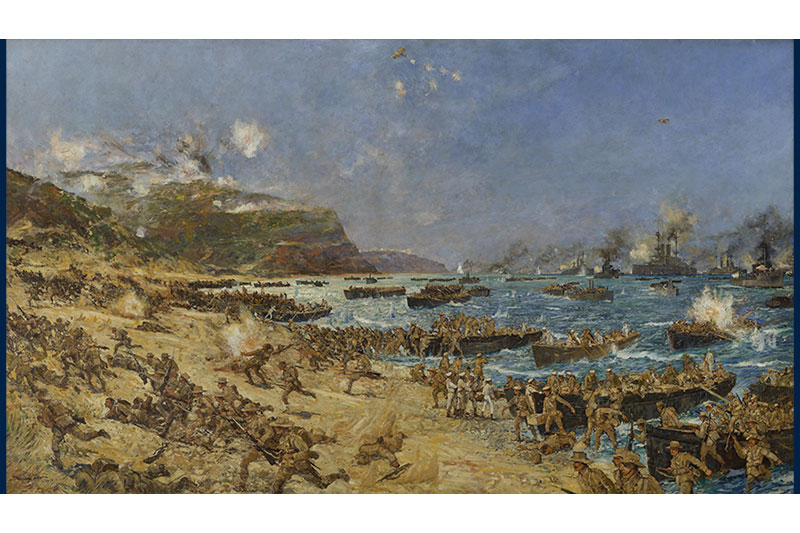
Charles Dixon (1915). The Landing at Gallipoli. Oil on canvas. Parliament House Art Collection. Black and white framed prints of this painting can still be found in some Districts and Sub Branches.
Dixon’s painting struck a chord with the Australian public. Thousands of people flocked to the gallery to view the work and, for those bereaved by events at Gallipoli, it provided solace by revealing the previously imagined context of a loved one’s death.
For others, the canvas offered a first glimpse at the event touted as “the young nation’s baptism of blood”. Images of the artwork were printed in newspapers and framed black and white reproductions proved popular with schools, public buildings and Returned Sailors and Soldiers Imperial League of Australia (RSSILA) Districts and Sub Branches.
With few exceptions and despite changes to the publication’s banner, The Landing at Gallipoli remained an integral element of The Queensland Digger’s cover for nine years.
Honouring the ANZACs through evolving art
In February 1934, The Queensland Digger was relaunched with a fresh new format that included special ANZAC numbers (issues) featuring coloured cover art. While early commemorative numbers incorporated simple sketches related to remembrance – a laurel wreath and an eternal flame – their subject matter gradually evolved to include complex messages about memory, loss and grief.
In 1936, The Queensland Digger commissioned Ian McBain (1905-1995), a cartoonist with The Courier Mail, to design a series of covers for the publication. His 1938 ANZAC number featured ANZAC Square just as dawn breaks across the Brisbane skyline.
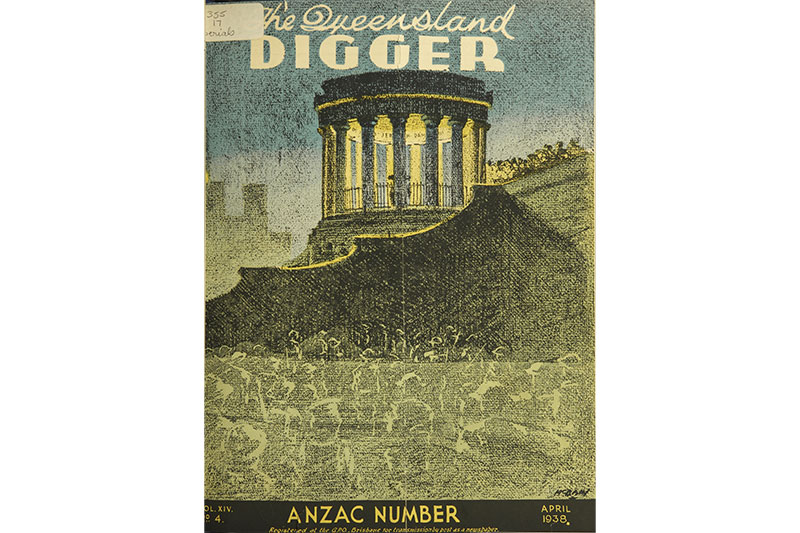
The Queensland Digger: April 1938. Cover art by Ian McBain.
To the right, a crowd huddles in the glow of the cenotaph’s eternal flame while the memory of the fallen – whether family members or comrades – stand watch in the shadows below. In his haunting depiction of a Dawn Service, McBain channelled what is arguably the most powerful commemorative painting in the nation’s memory of war: Menin Gate at Midnight (1927).
The haunting appeal of Menin Gate at Midnight
In July 1927, the Menin Gate Memorial was unveiled in Belgium to commemorate the missing British and Commonwealth men lost to battles around Ypres. Its poignant epitaph, “They are not missing. They are here”, was carefully crafted to provide comfort to thousands of bereaved family members.
Australian war artist Will Longstaff (1879-1953) had served in the area during the war and attended the monument’s unveiling. Unable to sleep that night, he went for a walk along Menin Road.
Just as the town clock pealed at midnight, Longstaff “…felt, and then actually saw, thousands of phantom Diggers arising from the ground, quietly, serenely, but grimly watching… the harder I looked, the more I saw” he told a journalist before adding, “No, I was not drunk”. The artist remained haunted by his vision until he was able to commit it to canvas.
In early 1928, the Secretary of Queensland’s London office brought the painting to the attention of British philanthropist Lord Woolavington, who subsequently purchased it for 2000 guineas (£2,100). It was hoped that Brisbane would benefit from the Lord’s largesse; however, he instead gifted the canvas to the Australian Government.
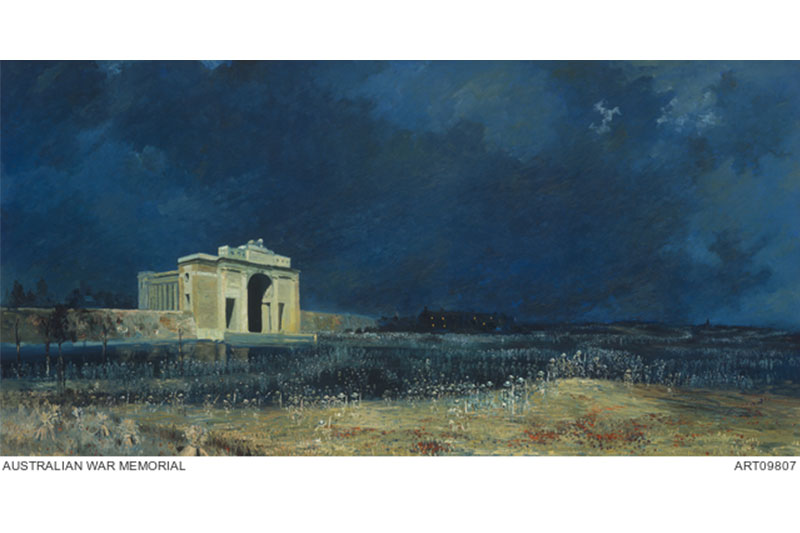
Will Longstaff (1927). Menin Gate at Midnight. Oil on Canvas. AWM ART09807. The artist donated 400 signed colour copies of his painting to the RSSILA. These were sold for £10/10/- each and the funds were divided among RSL State Branches.
Menin Gate at Midnight created a sensation when exhibited in Britain and Australia. Longstaff’s subject matter tapped directly into the profound emotions of loss and anxiety that a battlefield death represented to the bereaved.
It also presented the comforting illusion that death was not the end and that loved ones who lay in foreign lands far away were not alone. During its exhibition in London, a mother who grieved three sons lost at Ypres, visited the painting daily and searched for the familiar faces of her boys among the ghostly army. She admitted that Longstaff’s work provided her with “a greater consolation than if I could visit their graves… somehow I now know that they are happy and not really lost”.
Upon its arrival in Australia, Menin Gate at Midnight toured the nation’s state capitals and major cities. The RSSILA ensured that its arrival in Brisbane corresponded with the Ekka (Royal Queensland Show) so that regional visitors could view the work.
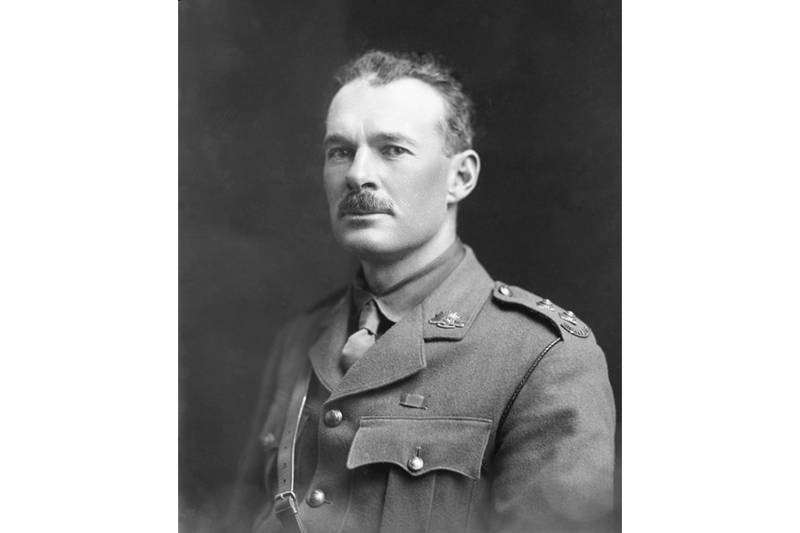
Will Longstaff. AWM J01940. Longstaff fought in both the Boer War and WWI before being appointed as an Australian war artist in 1918.
It is probable that Ian McBain was among the 50,000 Queenslanders who patiently waited outside the city’s new town hall to view the canvas during August 1929. He would have witnessed the profound emotional impact it had upon those who searched for a familiar face amid Longstaff’s moonlit shadows.
Rather than being merely decorative in nature, the early covers of The Queensland Digger played a much more important role. Their commemorative artwork connected members with the shared experience of war while also providing context and comfort related to the ongoing pain of a battlefield loss.
Keep up with RSL News
Queensland RSL News is published every quarter, highlighting engaging veteran news, stories, events, history and more. All RSL Queensland members receive a copy in the mail as part of their membership, while members of the public can read the latest edition online or subscribe to receive a digital copy via editor@rslqld.org.
Related News
Loading

